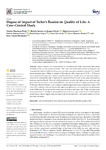Mostrar o rexistro simple do ítem
Degree of Impact of Tailor’s Bunion on Quality of Life: A Case–Control Study
| dc.contributor.author | Mazoteras-Pardo, Victoria | |
| dc.contributor.author | Becerro-de-Bengoa-Vallejo, Ricardo | |
| dc.contributor.author | Losa Iglesias, Marta Elena | |
| dc.contributor.author | Palomo-López, Patricia | |
| dc.contributor.author | López-López, Daniel | |
| dc.contributor.author | Calvo-Lobo, César | |
| dc.contributor.author | Romero Morales, Carlos | |
| dc.contributor.author | Casado-Hernández, Israel | |
| dc.date.accessioned | 2021-02-02T09:03:29Z | |
| dc.date.available | 2021-02-02T09:03:29Z | |
| dc.date.issued | 2021-01 | |
| dc.identifier.citation | Mazoteras-Pardo, V.; Becerro-de-Bengoa-Vallejo, R.; Losa-Iglesias, M.; Palomo-López, P.; López-López, D.; Calvo-Lobo, C.; Romero-Morales, C.; Casado-Hernández, I. Degree of Impact of Tailor’s Bunion on Quality of Life: A Case–Control Study. Int. J. Environ. Res. Public Health 2021, 18, 736 | es_ES |
| dc.identifier.issn | 1660-4601 | |
| dc.identifier.uri | http://hdl.handle.net/2183/27261 | |
| dc.description.abstract | [Abstract] Tailor’s bunion (TB) disease should be considered one of the foot injuries that causes disability in feet as well as general health. This case–control descriptive study investigated and contrasted the effects of different TB types in a sociodemographic population using the Foot Health Status Questionnaire (FHSQ). A sample of 100 subjects with a mean age of 51.70 ± 17.78 years was recruited and requested to reply to a foot health survey. Results were self-reported. Subjects were scored. Participants with TB type III (TB3) registered lower scores for foot pain, foot function, footwear, and foot health. Physical activity and social capacity had higher scores, and vigor and general health were lower. A Kruskal–Wallis test was used for systematic differences between the FHSQ and different TB types. In all analyses, statistical significance was considered a p-value <0.05 with a 95% confidence interval. Statistically significant differences were found between all domains of the FHSQ and TB, except for the social capacity domain and vigor. The FHSQ is an important measurement tool in TB subjects, showing that factors such as sex, age, and footwear used throughout an individual’s life are significantly associated with the development of TB3 and its influence on foot pain and foot health. | es_ES |
| dc.language.iso | eng | es_ES |
| dc.publisher | MDPI | es_ES |
| dc.relation.uri | https://doi.org/10.3390/ijerph18020736 | es_ES |
| dc.rights | Atribución 4.0 Internacional | es_ES |
| dc.rights.uri | http://creativecommons.org/licenses/by/4.0/ | * |
| dc.subject | Foot | es_ES |
| dc.subject | Foot deformities | es_ES |
| dc.subject | Foot diseases | es_ES |
| dc.subject | Musculoskeletal diseases | es_ES |
| dc.subject | Quality of life | es_ES |
| dc.subject | Pie | es_ES |
| dc.subject | Deformidades del pie | es_ES |
| dc.subject | Enfermedades del pie | es_ES |
| dc.subject | Enfermedades musculoesqueléticas | es_ES |
| dc.subject | Calidad de vida | es_ES |
| dc.title | Degree of Impact of Tailor’s Bunion on Quality of Life: A Case–Control Study | es_ES |
| dc.type | info:eu-repo/semantics/article | es_ES |
| dc.rights.access | info:eu-repo/semantics/openAccess | es_ES |
| UDC.journalTitle | International Journal of Environmental Research and Public Health | es_ES |
| UDC.volume | 18 | es_ES |
| UDC.issue | 2 | es_ES |
| UDC.startPage | 736 | es_ES |
Ficheiros no ítem
Este ítem aparece na(s) seguinte(s) colección(s)
-
GI-UDISAP - Artigos [196]






